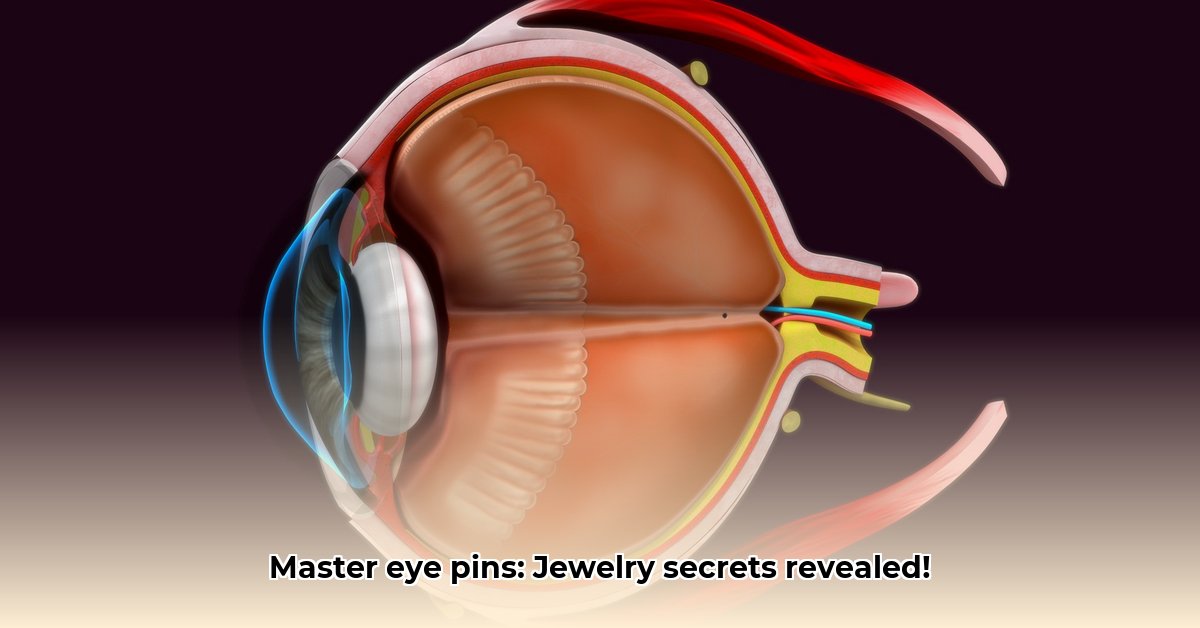Ready to take your jewelry making to the next level? This comprehensive guide is your definitive resource for everything eye pins. We’ll demystify what they are, guide you in selecting the perfect ones for your projects, and show you how to wield them like a seasoned professional. Consider this your secret weapon for crafting stunning jewelry – say goodbye to struggling with those tiny components! We’ll also share insider tips on sourcing the highest quality eye pins and maintaining their pristine condition. Whether you’re a novice or an experienced jewelry designer, you’ll discover invaluable insights here. For inspiration on other crafting projects, check out these piercing ideas. Let’s ignite your creativity!
Eye Pins: Your Comprehensive Guide to Jewelry Making
Let’s embark on a journey into the fascinating realm of eye pins! These seemingly simple wire elements are the cornerstone of countless exquisite jewelry creations, and mastering their use unlocks a vast spectrum of creative possibilities. This definitive guide will lead you through every essential aspect, from selecting the most suitable pin to resolving common issues like bent pins.
Part 1: Unveiling Eye Pins – Demystifying the Basics
Picture a slender, robust wire featuring a loop at one end – that’s the essence of an eye pin! These often-overlooked components are the crucial connectors in jewelry making, uniting beads, charms, and pendants to produce captivating designs. Their versatility is unmatched, and they’re available in a remarkable variety of materials, sizes, and finishes, guaranteeing a perfect eye pin for every conceivable project.
Consider the material options: Sterling silver exudes a timeless, refined elegance, while gold-filled lends a touch of opulence. Brass and copper serve as appealing, budget-conscious alternatives, each possessing a distinctive charm. Copper, in particular, develops a captivating patina over time, imbuing your designs with character and depth.
Size is also a critical factor! Eye pins are classified by their gauge (thickness) and length. A higher gauge number signifies a thinner wire, ideal for intricate and delicate work. Conversely, lower gauge numbers correspond to thicker wire, providing superior support for heavier pendants and charms. Envision it like selecting thread for sewing – you wouldn’t employ heavy-duty thread for delicate embroidery, would you? The length dictates the amount of pin available for integration into your design.
(Image showcasing an assortment of eye pins in diverse materials, gauges, and lengths could go here)
Part 2: Selecting Your Ideal Eye Pin – A Tailored Approach
Choosing the right eye pin is akin to selecting the perfect brush for a painting – it can significantly influence the outcome of your project!
Begin by assessing the metal. Sterling silver is a perennially stylish choice; its subtle radiance complements a myriad of designs. Its inherent resistance to tarnish is an added advantage! Gold-filled imparts a more luxurious feel and boasts impressive durability. Brass and copper present more accessible options, each offering a distinct aesthetic. However, copper necessitates more diligent care to prevent tarnishing.
Next, contemplate the gauge. For delicate applications, such as incorporating tiny seed beads, a thinner gauge (higher number) is optimal. For more substantial pendants or charms, a thicker gauge (lower number) provides the necessary robustness and support.
Lastly, consider the finish. Do you desire a lustrous, polished appearance or a more understated matte finish? The finish subtly shapes the overall aesthetic of your piece.
Here’s a comprehensive table summarizing your options:
| Metal Type | Pros | Cons | Ideal For |
|---|---|---|---|
| Sterling Silver | Timeless aesthetic, relatively tarnish-resistant with proper care | Higher cost compared to base metals | Delicate jewelry, elegant pendants, pieces intended for long-term wear |
| Gold-Filled | Luxurious appearance, durable, tarnish-resistant when properly maintained | Higher cost than base metals, though more affordable than solid gold | Statement pieces, heavier pendants, jewelry designed for frequent use |
| Brass | Affordable, versatile finishes, easy to manipulate | Prone to tarnishing, may necessitate protective coatings | Budget-friendly jewelry, rustic or vintage-inspired styles, experimental designs |
| Copper | Affordable, develops a unique patina, adds warmth | Tarnishes rapidly if not properly sealed, requires consistent cleaning and care | Bohemian jewelry, pieces with a vintage or antique aesthetic, mixed metal designs |
| Stainless Steel | Extremely durable, highly resistant to tarnish and corrosion | Can be more challenging to work with compared to softer metals | Everyday wear jewelry, pieces requiring exceptional strength and durability |
Part 3: Mastering the Craft – A Step-by-Step Guide to Eye Pin Mastery
Let’s get to the fun part! Here’s a clear, concise guide on using eye pins with confidence in your jewelry making endeavors.
Step 1: Assemble Your Essentials: You’ll require your chosen eye pins, jump rings (small connecting loops), beads or pendants, round-nose pliers (for shaping wire), flat-nose pliers (for securely closing jump rings), and wire cutters (for trimming excess wire).
Step 2: Precisely Attaching Jump Rings: Using your round-nose pliers, gently manipulate a jump ring open. Exercise caution not to open it too excessively, as this could distort its shape. Carefully connect the open jump ring to the eye pin loop. Employ your flat-nose pliers to meticulously close the jump ring completely, ensuring there are no visible gaps. A slightly overlapping closure provides the most secure connection and prevents accidental opening.
Step 3: Skillfully Adding Your Charms or Beads: Attach your beads or pendants to the jump ring. If you’re incorporating multiple beads or pendants, add them one at a time to ensure a robust and secure connection.
Step 4: Expert Troubleshooting: Encountered a bent eye pin? Don’t despair! Carefully employ your round-nose pliers to gently reshape it, if possible. However, if the pin snaps or breaks, replacement is necessary. Always select the correct size pliers and apply gentle, controlled pressure to avert damage to the wire.
Part 4: Sourcing, Preservation, and Maintaining the Luster of Your Eye Pins
Locating premium quality eye pins is simpler than you might imagine! Online retailers, craft emporiums, and specialized jewelry supply stores are all excellent resources. Etsy is a particularly valuable platform for supporting independent artisans and discovering unique, handcrafted options.
Proper storage is indispensable for preserving the beauty and extending the lifespan of your eye pins. Store them within a sealed container or airtight bag, ideally in a dark, cool, and dry environment. This will effectively mitigate tarnish and oxidation, especially crucial for copper and brass components. Consider adding a desiccant packet to the container to further absorb moisture.
Routine cleaning and maintenance will ensure they retain their brilliance. For sterling silver and gold-filled pins, a gentle polishing cloth is generally sufficient. Brass and copper may necessitate a specialized cleaning solution or a protective coating to effectively prevent tarnishing.
Remember that your choices as a jewelry maker extend beyond the immediate project – consider supporting ethical and sustainable suppliers to minimize your environmental impact. The journey toward crafting beautiful, unique jewelry can also be a conscious step towards mindful creation and responsible sourcing.
How to Select and Utilize Sustainable Eye Pins for Responsible Jewelry Making
Key Takeaways:
- Eye pins are fundamental and versatile components in jewelry making
- Material selection significantly impacts both durability and aesthetic appeal.
- Gauge (wire thickness) dictates strength and ease of manipulation.
- Prioritizing sustainable sourcing is paramount for ethical jewelry creation.
- Employing proper techniques guarantees robust and visually appealing projects.
Part 1: Deep Dive into Eye Pins
What precisely are eye pins? They’re deceptively simple, yet extraordinarily versatile, lengths of wire featuring a pre-formed loop at one terminus. Conceptualize them as the connective tissues within your jewelry designs. They secure beads, charms, and other elements in place, enabling the creation of everything from delicate earrings to robust necklaces. Eye pins are available in a diverse array of materials—sterling silver, gold-filled, brass, copper, and even stainless steel—each exhibiting distinct properties. The size, or gauge, of the wire is also a crucial consideration: finer gauges are preferable for intricate work, while heavier gauges are essential for supporting more substantial pendants. Finally, a wide range of finishes exist, from polished to matte, further expanding your design choices.
Part 2: The Art of Eye Pin Selection
Selecting the appropriate eye pin is contingent upon the nature of your project. What specific piece are you crafting? What materials will you employ? Evaluate the weight of the components you intend to connect. Heavier elements necessitate ticker gauge eye pins to prevent unwelcome bending or distortion. For more delicate designs, thinner gauges provide a more refined and subtle aesthetic. Ponder the intended style, too. A matte finish often harmonizes well with rustic or earthy designs, while a polished finish complements sleek, contemporary pieces. This is where “how to choose sustainable eye pins for jewelry making” becomes important.
| Material | Pros | Cons | Sustainability Considerations |
|---|---|---|---|
| Sterling Silver | Classic aesthetic, durable with proper care, relatively tarnish-resistant with proper maintenance | Higher cost compared to base metals | Prioritize recycled sterling silver whenever feasible. Support suppliers with ethical sourcing practices. |
| Gold-Filled | Luxurious aesthetic, durable, offers a more affordable alternative to solid gold | Higher cost than base metals | Seek out recycled or |
- Bulking Lunch Recipes that Make Muscle Gain Delicious - November 12, 2025
- Simple Asian Meal Prep Recipes to Spice Up Your Week - November 11, 2025
- Simple Asian Meal Prep Ideas For Healthy And Flavorful Weekday Meals - November 10, 2025










